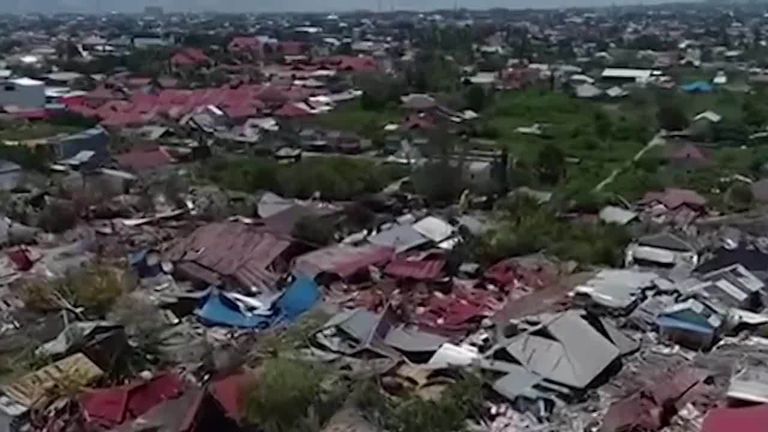Lootings, prison breaks and IS: Aid route to tsunami zone
Sky News' Mark Stone reports on a lack of any co-ordinated government response as he journeys through Sulawesi after the disaster.
Wednesday 3 October 2018 12:24, UK
There is a certain degree of safety in numbers on the road north to the disaster zone.
We are travelling in a convoy because the risk, further ahead, of being stopped and robbed is now high.
Not only are there desperate people willing to steal, but two prisons have been damaged and security breached. Around 1,200 inmates now roam somewhere in the northern Sulawesi countryside.
But before contending with all that, there's the challenge of gathering the supplies and personnel.
I'm with my colleagues, producer Sophia McBride and cameraman Ed Young, and a full day has passed just for us to get on the move.
It's taken hours for the volunteer aid teams to come together and to source supplies - medical kits, food, water and fuel. Some of it has been sent from other more developed islands.
We are the guests of an Indonesian doctor and his team.
Chandra Sembiring has worked for Medicines Sans Frontiers in Afghanistan and has rescued climbers off Everest but for the past few months, his skills have been needed most at home.
The multiple quakes over the summer across the archipelago that makes up Indonesia has exhausted rescue workers and devastated communities.
On the island of Lombok a few weeks ago, the devastation was bad but access wasn't too hard. And there was no tsunami to cope with.
Here in Sulawesi, it's different. It has now become clear that the area of devastation is actually quite compact. But in that area - the port city of Palu - it is complete devastation.
The topography of the area - a city built in a narrow low-lying strip of land at the southern end of a narrow bay - was tragically perfect for funnelling the power of a tsunami as it barrelled inland.
And it turns out the same topography is also perfect for hampering the ability for teams to get to the place. Multiple landslides and collapsed bridges have cut the city off.
As we set out on our journey, some two hundred miles down the west coast of Sulawesi from the disaster zone, the only way in was by road - a 15-hour drive, at least.
As I write, we are about half way. There are now a few flights landing in Palu but not nearly enough to get the aid that's needed.
In our vehicles are local doctors and medics as well as communications specialists from the French charity Telecoms Sans Frontiers (TSF).
Their work is less obvious than the medical need, but just as vital. Without communications, it's hard to get anything happening with any efficiency.
We stop frequently, to ensure the convoy stays together and to inform the military of our movements. It's a chance to catch up with some of the team.
Sebastien Latouille runs the TSF operation.
He tells me: "The first thing when we hit the ground is to get in touch with our partners at the government centre and see what the priorities are for internet connections.
"We set up the internet connections - it takes us a couple of hours to do that, to get them back up and running - and then we send a few teams around to contact the population and provide the free calling operations." Mr Latouille says.
Team leader Dr Sembiring says: "We need to make sure everything is okay for the security issue because we have now done co-ordination with the army. And they have put the army on the road from Donggala to Palu. So it's safe now."
We drive on into the Indonesian night. It's not ideal to be on these roads at dark but the team want to get there.
There is an 11pm stop for dinner: a ramshackle roadside hut with memorable loos and some delicious fried chicken, rice and homemade chilli sauce. It's a chance as well to send our evening TV news report into Sky HQ before the mobile network fizzles away.
We drive on and I watch a video that's emerged via the local Disaster Mitigation Agency. It's was filmed just as the quake hit on Friday evening and it's chilling.
Filmed by a brave soul (I have no idea how they survived) from the tin roof of a shack, it shows the land all around moving, flowing like a liquid but not quite like a river or a flood.
It looks almost unbelievable; computer-generated. But this was Mother Nature, demonstrating a phenomenon called liquefaction.
It happens when saturated soil loses its stiffness because of the violent underground tremors. The ground literally turns to liquid.
It is the aftermath of this that the convoys of aid teams must contend with when they arrive.
There is one more complication which had been mentioned as a potential concern. Sulawesi has a particular but isolated problem with Islamist extremism. A group called Mujahidin Indonesia Timur (MIT) has its base in the jungles of this island.
MIT's leader, Santoso, who pledged an alliance to the self-styled Islamic State (IS), was killed in 2016 by Indonesian police in Poso, 100 miles or so inland from Palu City.
But the turnout at his funeral hints at an IS support base large enough to worry the authorities.
What has struck me through this journey though is the lack of any co-ordinated government response.
We've not seen the sort of large government-led truck convoys I've watched in other disasters like the Nepal earthquake in 2015 and the Philippines typhoon in 2013.
Here, at the moment, it's bitty, sporadic and too often left to people like Dr Chandra and his teams.










